Valletta
Valletta (/vəˈlɛtə/, Maltese: il-Belt Valletta, Maltese pronunciation: [vɐˈlːɛtːɐ]) is the capital city of Malta. Located in the South Eastern Region of the main island, between Marsamxett Harbour to the west and the Grand Harbour to the east, its population in 2014 was 6,444,[4] while the metropolitan area around it has a population of 393,938.[3] Valletta is second only to Nicosia as the southernmost capital of Europe,[5] and at just 0.61 square kilometres (61 ha), it is the European Union's smallest capital city.[6][7]
Valletta Il-Belt Valletta | |||||||||||||||
|---|---|---|---|---|---|---|---|---|---|---|---|---|---|---|---|
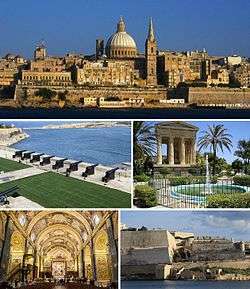 From top: Skyline, Saluting Battery, Lower Barrakka Gardens, St. John's Co-Cathedral and the city walls | |||||||||||||||
 Flag 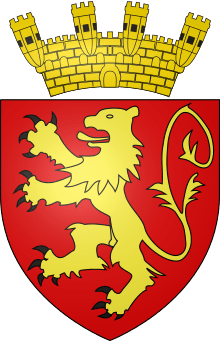 Coat of arms | |||||||||||||||
| Nickname(s): Il-Belt | |||||||||||||||
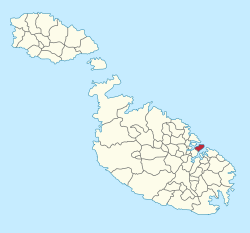 Map of the Maltese Archipelago with Valletta highlighted in red. | |||||||||||||||
| Coordinates: 35°53′54″N 14°30′45″E[1] | |||||||||||||||
| Country | Malta | ||||||||||||||
| Region | South Eastern Region | ||||||||||||||
| District | Southern Harbour District | ||||||||||||||
| Established | 28 March 1566 | ||||||||||||||
| Capital city | 18 March 1571 | ||||||||||||||
| Founded by | Jean de Parisot Valette | ||||||||||||||
| Borders | Floriana | ||||||||||||||
| Government | |||||||||||||||
| • Mayor | Alfred Zammit (PL) | ||||||||||||||
| Area | |||||||||||||||
| • Capital city and local council | 0.61 km2 (0.24 sq mi) | ||||||||||||||
| Elevation | 56 m (184 ft) | ||||||||||||||
| Population (Jan. 2019) | |||||||||||||||
| • Capital city and local council | 5,827 | ||||||||||||||
| • Density | 9,600/km2 (25,000/sq mi) | ||||||||||||||
| • Urban | 355,000[2] | ||||||||||||||
| • Metro | 393,938[3] | ||||||||||||||
| Demonym(s) | Belti (m), Beltija (f), Beltin (pl) or Vallettan (m), Vallettana (f), Vallettani (pl) | ||||||||||||||
| Time zone | UTC+1 (CET) | ||||||||||||||
| • Summer (DST) | UTC+2 (CEST) | ||||||||||||||
| Postal code | VLT | ||||||||||||||
| Dialing code | 356 | ||||||||||||||
| ISO 3166 code | MT-60 | ||||||||||||||
| Patron saints | St. Dominic Our Lady of Mount Carmel St. Paul St. Augustine | ||||||||||||||
| Day of festa | 3 August 10 February | ||||||||||||||
| Website | Official website | ||||||||||||||
| |||||||||||||||
Valletta's 16th-century buildings were constructed by the Knights Hospitaller. The city was named after Jean Parisot de Valette, who succeeded in defending the island from an Ottoman invasion in 1565. The city is Baroque in character, with elements of Mannerist, Neo-Classical and Modern architecture, though the Second World War left major scars on the city, particularly the destruction of the Royal Opera House. The city was officially recognised as a World Heritage Site by UNESCO in 1980.[8]
The city's fortifications, consisting of bastions, curtains and cavaliers, along with the beauty of its Baroque palaces, gardens and churches, led the ruling houses of Europe to give the city its nickname Superbissima – Latin for "Proudest".
History

The peninsula was previously called Xagħret Mewwija (Mu' awiya – Meuia; named during the Arab period[9])[10][11] or Ħal Newwija.[12] Mewwija refers to a sheltered place.[13] The extreme end of the peninsula was known as Xebb ir-Ras (Sheb point), of which name origins from the lighthouse on site.[14][15] A family which surely owned land became known as Sceberras, now a Maltese surname as Sciberras.[16] At one point the entire peninsula became known as Sceberras.[15] (See also)
French Republic 1798–1800
Protectorate of Malta 1800–1813
Crown Colony of Malta 1813–1964
State of Malta 1964–1974
Order of Saint John
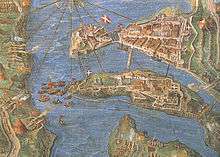
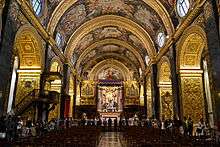
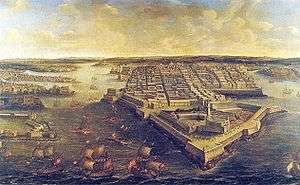
The building of a city on the Sciberras Peninsula had been proposed by the Order of Saint John as early as 1524.[17] Back then, the only building on the peninsula was a small watchtower[18] dedicated to Erasmus of Formia (Saint Elmo), which had been built in 1488.[19]
In 1552, the Aragonite watchtower was demolished and the larger Fort Saint Elmo was built in its place.[20]
In the Great Siege of 1565, Fort Saint Elmo fell to the Ottomans, but the Order eventually won the siege with the help of Sicilian reinforcements. The victorious Grand Master, Jean de Valette, immediately set out to build a new fortified city on the Sciberras Peninsula to fortify the Order's position in Malta and bind the Knights to the island. The city took his name and was called La Valletta.[21]
The Grand Master asked the European kings and princes for help, and he received a lot of assistance, due to the increased fame of the Order after their victory in the Great Siege. Pope Pius V sent his military architect, Francesco Laparelli, to design the new city, while Philip II of Spain sent substantial monetary aid. The foundation stone of the city was laid by Grand Master de Valette on 28 March 1566. He placed the first stone in what later became Our Lady of Victories Church.[22]
In his book Dell’Istoria della Sacra Religione et Illustrissima Militia di San Giovanni Gierosolimitano (English: The History of the Sacred Religion and Illustrious Militia of St John of Jerusalem), written between 1594 and 1602, Giacomo Bosio writes that when the cornerstone of Valletta was placed, a group of Maltese elders said: "Iegi zimen en fel wardia col sceber raba iesue uquie" (Which in modern Maltese reads, "Jiġi żmien li fil-Wardija [l-Għolja Sciberras] kull xiber raba' jiswa uqija", and in English, "There will come a time when every piece of land on Sciberras Hill will be worth its weight in gold").[23]
De Valette died from a stroke on 21 August 1568 at age 74 and never saw the completion of his city. Originally interred in the church of Our Lady of the Victories, his remains now rest in St. John's Co-Cathedral among the tombs of other Grand Masters of the Knights of Malta.[22]
Francesco Laparelli was the city's principal designer and his plan departed from medieval Maltese architecture, which exhibited irregular winding streets and alleys. He designed the new city on a rectangular grid plan, and without any collacchio (an area restricted for important buildings). The streets were designed to be wide and straight, beginning centrally from the City Gate and ending at Fort Saint Elmo (which was rebuilt) overlooking the Mediterranean; certain bastions were built 47 metres (154 ft) tall. His assistant was the Maltese architect Girolamo Cassar, who later oversaw the construction of the city himself after Laparelli's death in 1570.[22]
The Ufficio delle Case regulated the building of the city as a planning authority.[24]
The city of Valletta was mostly complete by the early 1570s, and it became the capital on 18 March 1571 when Grand Master Pierre de Monte moved from his seat at Fort St Angelo in Birgu to the Grandmaster's Palace in Valletta.
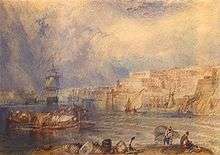
Seven Auberges were built for the Order's Langues, and these were complete by the 1580s.[25][26] An eighth Auberge, Auberge de Bavière, was later added in the 18th century.[27]
In Antoine de Paule's reign, it was decided to build more fortifications to protect Valletta, and these were named the Floriana Lines after the architect who designed them, Pietro Paolo Floriani of Macerata.[28] During António Manoel de Vilhena's reign, a town began to form between the walls of Valletta and the Floriana Lines, and this evolved from a suburb of Valletta to Floriana, a town in its own right.[29]
In 1634, a gunpowder factory explosion killed 22 people in Valletta.[30] In 1749, Muslim slaves plotted to kill Grandmaster Pinto and take over Valletta, but the revolt was suppressed before it even started due to their plans leaking out to the Order.[31] Later on in his reign, Pinto embellished the city with Baroque architecture, and many important buildings such as Auberge de Castille were remodeled or completely rebuilt in the new architectural style.[32]
In 1775, during the reign of Ximenes, an unsuccessful revolt known as the Rising of the Priests occurred in which Fort Saint Elmo and Saint James Cavalier were captured by rebels, but the revolt was eventually suppressed.[33]
French occupation and British rule
.jpg)
In 1798, the French invaded the island and expelled the Order.[34] After the Maltese rebelled, French troops continued to occupy Valletta and the surrounding harbor area, until they capitulated to the British in September 1800. In the early 19th century, the British Civil Commissioner, Henry Pigot, agreed to demolish the majority of the city's fortifications.[35] The demolition was again proposed in the 1870s and 1880s, but it was never carried out and the fortifications have survived largely intact.[17]
Eventually building projects in Valletta resumed under British rule. These projects included widening gates, demolishing and rebuilding structures, widening newer houses over the years, and installing civic projects. The Malta Railway, which linked Valletta to Mdina, was officially opened in 1883.[36] It was closed down in 1931 after buses became a popular means of transport.
In 1939, Valletta was abandoned as the headquarters of the Royal Navy Mediterranean Fleet due to its proximity to Italy and the city became a flash point during the subsequent two-year long Siege of Malta.[37] German and Italian air raids throughout the Second World War caused much destruction in Valletta and the rest of the harbor area. The Royal Opera House, constructed at the city entrance in the 19th century, was one of the buildings lost to the raids.[20]
.jpg) Valletta harbour around 1850, photo by Calvert Jones
Valletta harbour around 1850, photo by Calvert Jones.jpg) 1853 King's Gate
1853 King's Gate Royal Opera House in 1911
Royal Opera House in 1911 Bomb damage in Valletta during the Second World War
Bomb damage in Valletta during the Second World War
Contemporary
In 1980, the 24th Chess Olympiad took place in Valletta.[38]
The entire city of Valletta has been a UNESCO World Heritage Site since 1980, along with Megalithic Temples of Malta and the Hypogeum of Ħal-Saflieni.[8][39] On 11 November 2015 Valletta hosted the Valletta Summit on Migration in which European and African leaders discussed the European migrant crisis.[40] After that, on 27 November 2015 the city also hosted part of the Commonwealth Heads of Government Meeting 2015.[41]
Valletta was the European Capital of Culture in 2018.[42]
 Renzo Piano's Valletta City Gate (2014)
Renzo Piano's Valletta City Gate (2014)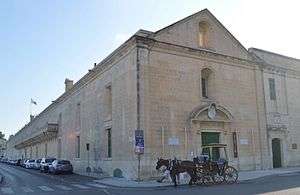 Mediterranean Conference Centre, former Sacra Infermeria (2016)
Mediterranean Conference Centre, former Sacra Infermeria (2016) Renovated Tritons’ Fountain (2018)
Renovated Tritons’ Fountain (2018)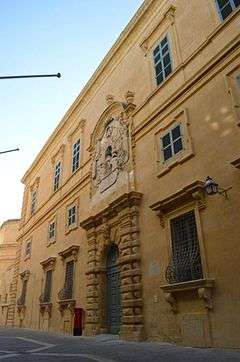 Auberge d'Italie, renovated in 2016 to host the new MUŻA (Mużew Nazzjonali tal-Arti)
Auberge d'Italie, renovated in 2016 to host the new MUŻA (Mużew Nazzjonali tal-Arti)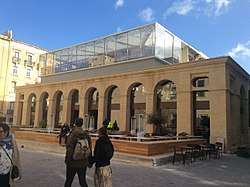 Renovated covered market Is-Suq tal-Belt, 2018
Renovated covered market Is-Suq tal-Belt, 2018
Government
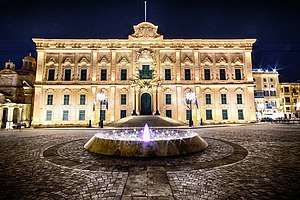
(2015)
Local government
The Valletta Local Council was established by the Local Councils Act of 1993, along with the other local councils of Malta.[43] The first election was held on 20 November 1993. Other elections were held in 1996, 1999, 2002, 2005, 2008, 2013,[44] 2017.[45] The present local council was elected in 2019.[46] The local council is housed in a building in South Street.
The following people have served as Mayors of Valletta:[47]
- Hector Bruno (1993–1999)
- Paul Borg Olivier (1999–2008)
- Alexei Dingli (2008–2019)[48]
- Christian Micallef (2019)[49]
- Alfred Zammit (2019)[50]
National government
Valletta is the capital city of Malta,[51] and is the country's administrative and commercial hub.[52] The Parliament of Malta is housed at the Parliament House near the city's entrance since 2015, and it was previously housed at the Grandmaster's Palace in the city centre.[53] The latter palace still houses the Office of the President of Malta,[54] while Auberge de Castille houses the Office of the Prime Minister of Malta. The courthouse and many government departments are also located in Valletta.[55]
Geography
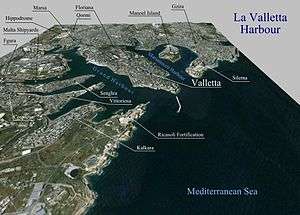
The Valletta peninsula has two natural harbours, Marsamxett and the Grand Harbour.[39] The Grand Harbour is Malta's major port, with unloading quays at nearby Marsa. A cruise-liner terminal is located along the old seawall of the Valletta Waterfront that Portuguese Grandmaster Manuel Pinto da Fonseca built.[56]
Climate
Valletta features a hot-summer Mediterranean climate with hot, slightly long, dry summers and mild, wet winters, with an average temperature above 19 °C (66 °F). Valletta experiences a lack of precipitation during the summer months and most of the precipitation happens during the winter months. Winter temperatures are moderated by the surrounding sea, as a result, the city has very mild winters. The official climate recording station in Malta is at Luqa Airport, which is a few miles inland from Valletta. Average high temperatures range from around 16 °C (61 °F) in January to about 32 °C (90 °F) in August, while average low temperatures range from around 10 °C (50 °F) in January to 23 °C (73 °F) in August.
| Climate data for Luqa Airport, Malta 1981–2010 (Records 1947–2010) | |||||||||||||
|---|---|---|---|---|---|---|---|---|---|---|---|---|---|
| Month | Jan | Feb | Mar | Apr | May | Jun | Jul | Aug | Sep | Oct | Nov | Dec | Year |
| Record high °C (°F) | 22.2 (72.0) |
26.7 (80.1) |
33.5 (92.3) |
30.7 (87.3) |
35.3 (95.5) |
40.1 (104.2) |
42.7 (108.9) |
43.8 (110.8) |
37.4 (99.3) |
34.5 (94.1) |
28.2 (82.8) |
24.3 (75.7) |
43.8 (110.8) |
| Average high °C (°F) | 15.6 (60.1) |
15.6 (60.1) |
17.3 (63.1) |
19.8 (67.6) |
24.1 (75.4) |
28.6 (83.5) |
31.5 (88.7) |
31.8 (89.2) |
28.5 (83.3) |
25.0 (77.0) |
20.7 (69.3) |
17.1 (62.8) |
23.0 (73.4) |
| Daily mean °C (°F) | 12.8 (55.0) |
12.5 (54.5) |
13.9 (57.0) |
16.1 (61.0) |
19.8 (67.6) |
23.9 (75.0) |
26.6 (79.9) |
27.2 (81.0) |
24.7 (76.5) |
21.5 (70.7) |
17.7 (63.9) |
14.4 (57.9) |
19.3 (66.7) |
| Average low °C (°F) | 9.9 (49.8) |
9.4 (48.9) |
10.6 (51.1) |
12.4 (54.3) |
15.5 (59.9) |
19.1 (66.4) |
21.7 (71.1) |
22.6 (72.7) |
20.8 (69.4) |
18.1 (64.6) |
14.6 (58.3) |
11.6 (52.9) |
15.5 (59.9) |
| Record low °C (°F) | 1.4 (34.5) |
1.7 (35.1) |
2.2 (36.0) |
4.4 (39.9) |
8.0 (46.4) |
12.6 (54.7) |
15.5 (59.9) |
15.9 (60.6) |
13.2 (55.8) |
8.0 (46.4) |
5.0 (41.0) |
3.6 (38.5) |
1.4 (34.5) |
| Average precipitation mm (inches) | 98.5 (3.88) |
60.1 (2.37) |
44.2 (1.74) |
20.7 (0.81) |
16.0 (0.63) |
4.6 (0.18) |
0.3 (0.01) |
12.8 (0.50) |
58.6 (2.31) |
82.9 (3.26) |
92.3 (3.63) |
109.2 (4.30) |
595.8 (23.46) |
| Average relative humidity (%) | 79 | 79 | 79 | 77 | 74 | 71 | 69 | 73 | 77 | 78 | 77 | 79 | 76 |
| Mean monthly sunshine hours | 159.0 | 171.0 | 224.0 | 247.0 | 300.0 | 328.0 | 365.0 | 338.0 | 260.0 | 221.0 | 185.0 | 156.0 | 2,954 |
| Source 1: Meteo Climate (1981-2010 Data),[57] | |||||||||||||
| Source 2: German Meteorological Service (sunshine duration 1961-1990)[58] NSO Malta[59] | |||||||||||||
Cityscape
The architecture of Valletta's streets and piazzas ranges from mid-16th century Baroque to Modernism. The city is the island's principal cultural center and has a unique collection of churches, palaces and museums and act as one of the city's main visitor attractions. When Benjamin Disraeli, future British Prime Minister, visited the city in 1830, he described it as "a city of palaces built by gentlemen for gentlemen," and remarked that "Valletta equals in its noble architecture, if it does not excel, any capital in Europe," and in other letters called it "comparable to Venice and Cádiz" and "full of palaces worthy of Palladio."[60][61]
Buildings of historic importance include St John's Co-Cathedral, formerly the Conventual Church of the Knights of Malta. It has the only signed work and largest painting by Michelangelo Merisi da Caravaggio.[62] The Auberge de Castille et Leon, formerly the official seat of the Knights of Malta of the Langue of Castille, Léon and Portugal, is now the office of the Prime Minister of Malta.[55] The Grandmaster's Palace, built between 1571 and 1574 and formerly the seat of the Grand Master of the Knights of Malta, used to house the Maltese Parliament, now situated in a purpose-built structure at the entrance to the city, and now houses the offices of the President of Malta.[63]
The National Museum of Fine Arts is a Rococo palace dating back to the late 1570s, which served as the official residence of the Commander-in-Chief of the Mediterranean Fleet during the British era from the 1820s onwards. The Manoel Theatre (Maltese: Teatru Manoel) was constructed in just ten months in 1731, by order of Grand Master António Manoel de Vilhena, and is one of the oldest working theatres in Europe. The Mediterranean Conference Centre was formerly the Sacra Infermeria. Built in 1574, it was one of Europe's most renowned hospitals during the Renaissance. The fortifications of the port, built by the Knights as a magnificent series of bastions, demi-bastions, cavaliers and curtains, approximately 100 metres (330 ft) high, all contribute to the unique architectural quality of the city.
Neighbourhoods
.jpg)
Valletta contains a number of unofficial neighbourhoods, including:[64]
- Strada Rjali – the main thoroughfare, Triq ir-Repubblika
- l-Arċipierku – an area close to the Sacra Infermeria. Its name possibly derives from archipelago since it contains a number of lanes which break up the area into many "islands" of houses, or from archi-borgo since the area is located just outside Fort Saint Elmo.[65]
- il-Baviera – an area around the English Curtain, bounded by Old Bakery, Archbishop, Marsamxett and St. Sebastian Streets. It is named after Auberge de Bavière.[65]
- il-Biċċerija – an area close to il-Baviera, named after the slaughterhouse which was formerly located there.[65]
- il-Kamrata – an area close to the Sacra Infermeria. It is named after the Camerata, a spiritual retreat which was demolished in the 19th century and replaced by social housing.[65]
- Deux Balles (Maltese: Duwi Balli) – an area close to il-Baviera. The name probably originates from the French occupation.[65]
- il-Fossa – an area close to the Jews' Sally Port and Fort Saint Elmo. It is regarded as the worst maintained area of Valletta.[66]
- Manderaggio (Maltese: il-Mandraġġ) – an area behind Manderaggio Curtain, bounded by St. Mark, St. Lucia, St. Patrick and Marsamxett Streets. This was meant to be a small harbour (mandracchio) but it was never completed, and a slum area developed instead. The slums were demolished in the 1950s and were rebuilt as housing estates.[65]
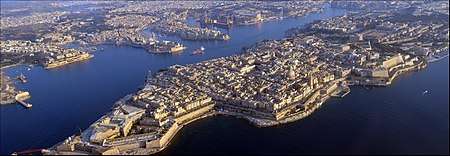
Education
The Valletta Campus of the University of Malta is situated in the Old University Building. It serves as an extension of the Msida Campus, especially offering international masters programmes.[67]
A church school, "St. Albert the Great", is also situated in Valletta. The Headmaster is Alternattiva Demokratika politician Mario Mallia.[68][69]
Culture
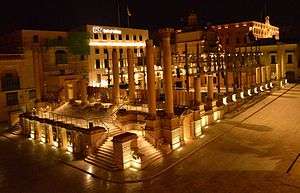

Valletta has been designated European Capital of Culture for 2018.[70] The year was inaugurated with an event called Erba' Pjazez (Four Squares), with shows focused in 4 plazas in the city – Triton Square, St. George's Square, St. John's Square, and Castille Square – along with other shows in other points.[71] This was followed by the unveiling of a public art installation, Kif Jgħid il-Malti (Maltese Sayings), which featured a number of Maltese language proverb figured in gypsum, in order to engage linguistic heritage.[72][73]
Saint James Cavalier
Saint James Cavalier, originally a raised gun platform, was converted into a Centre of Creativity in the year 2000 as part of Malta's Millennium Project. It now houses a small theatre, a cinema, music rooms and art galleries. Various exhibitions are regularly held there. Since it was opened it has welcomed over a million visitors.[74]
Music
The Valletta International Baroque Festival is held every year in January. Jazz music in Malta was introduced in the Strait Street area, frequented by Allied sailors during both world wars. Malta's Jazz Festival took place here. Strait Street is also known as The Gut. This area is undergoing a programme of regeneration. The city's dual band clubs are the "King's Own Band Club" (Maltese: L-Għaqda Mużikali King's Own) and "La Valette National Philharmonic Society" (Maltese: Is-Soċjetà Filarmonika Nazzjonali La Valette).
Carnival
Valletta is the scene of the Maltese Carnival, held in February leading up to Lent.[75] In 1823 the Valletta carnival was the scene of a human crush tragedy in which at least 110 boys perished.[76]
Feasts
- The feast of Our Lady of Mount Carmel is celebrated on 16 July
- Saint Paul's feast is celebrated on 10 February
- Saint Dominic's feast is celebrated in Valletta on 4 August or before
- The feast of Saint Augustine is celebrated on the third Sunday after Easter
- The city's residents also conduct an annual procession in honour of St. Rita
Transport
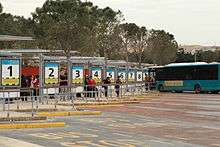
Malta International Airport is 8 kilometres (5.0 mi) from the city in the town of Luqa. Malta's public transport system, which uses buses, operates mostly on routes to or from Valletta, with their central terminus just outside the city gate. Traffic within the city itself is restricted, with some principal roads being completely pedestrian areas. In 2006, a park and ride system was implemented in order to increase the availability of parking spaces in the city. People can leave their vehicles in a nearby Floriana car park and transfer to a van for the rest of the trip.
In 2007, a congestion pricing scheme was implemented to reduce long-term parking and traffic while promoting business in the city.[78][79] An ANPR-based automated system takes photos of vehicles as they enter and exit the charging zone and vehicle owners are billed according to the duration of their stay.[78]
Valletta is served by a fleet of electric taxis which transport riders from 10 points in Valletta to any destination in the city.[80]
Notable people
Sports
- Valletta F.C. Association Football team
- Valletta Lions RFC Rugby Football Union team
- Valletta's Marsamxett Harbour a "Regatta" (Rowing) Team, which takes part in the annual traditional Regatta on Victory Day (8 September).
- Valletta United W.P.C., a water polo club hailing from Marsamxett side
Cultural references
- The poems


- Several chapters of Thomas Pynchon's postmodern novel V. take place in the city of Valletta.
- Much of Nicholas Rinaldi's novel The Jukebox Queen of Malta is set in Valletta.
- Several chapters of Patrick O'Brian's novel Treason's Harbour, the 9th in his Aubrey-Maturin series, are set in Valletta.
- A portion of Rick Riordan's novel The House of Hades is set in Valletta; here Jason Grace, Nico di Angelo, Piper McLean, Hazel Levesque and Frank Zhang reunite with their comrade Leo Valdez after Jason pilots their ship from the palace of Notus, god of the south wind, on the North African coast on a fast trip with Notus' storm spirits bound to the prow.
- Parts of Steven Spielberg's Academy Award nominee film Munich were shot in Valletta.[81]
- In the popular computer strategy game, Age of Empires III, Valletta and its surrounding areas are featured as the base of the main protagonist, Morgan Black, and is the setting for the first two levels of the game.
- Valletta is the birthplace of comic book character Corto Maltese, created by Italian artist Hugo Pratt.
- in Civilization V and Civilization VI Valletta is an independent City-State that players compete for influence over.
Further reading
- Bianco, Lino (2009). "Valletta: A city in history" (PDF). Melita Theologica. University of Malta: Department of Architecture and Urban Design – Faculty for the Built Environment. 60 (2): 1–20. ISSN 1012-9588. OCLC 1587122. Archived from the original (PDF) on 19 March 2018.
References
- Badger, George Percy (1869). Historical Guide to Malta and Gozo. Calleja. pp. 152.
Castellania building.
- "Study on Urban Functions, ESPON project 1.4.3" Archived 24 September 2015 at the Wayback Machine – European Observation Network for Territorial Development and Cohesion 2007, ISBN 2-9600467-2-2
- "Population by sex and age groups on 1 January". Eurostat. 15 April 2015. Retrieved 18 July 2015.
- "Estimated Population by Locality 31st March, 2014". Government of Malta. 16 May 2014. Archived from the original on 21 June 2015. Retrieved 21 June 2015.
- Valletta, Malta - Intercultural City - Council of Europe
- "The 10 Smallest Countries in Europe". World Atlas.
- "History of Valletta - Story About Valletta - Interesting Facts". www.visitmalta.com. Retrieved 29 February 2020.
- "City of Valletta". UNESCO World Heritage List. Retrieved 18 July 2015.
- "thinksite.eu" (PDF). Thinksite.eu.
- "'Xagħret Mewwija: L-Istorja tal-Belt … Milwija' aka Dragut's revenge - The Malta Independent". www.independent.com.mt.
- "The Secrets of underground Valletta – The Malta Independent". Independent.com.mt.
- p. 21, footnote 163.
- "p. 231" (PDF).
- Manley, Deborah (10 February 2012). "Malta: A Traveller's Anthology". Andrews UK Limited – via Google Books.
- Delbeke, M.; Schraven, M. (9 December 2011). "Foundation, Dedication and Consecration in Early Modern Europe". BRILL – via Google Books.
- de Piro.
- Attard, Sonia. "The Valletta Fortifications". aboutmalta.com. Retrieved 12 July 2015.
- Leopardi, E. R. (1949). "The First Printed Description of Malta : Lyons 1536" (PDF). Scientia. 15 (2): 56, 58.
- https://www.um.edu.mt/library/oar/bitstream/123456789/30600/1/Triton%20Square%20and%20Bisjuttin%20Area-Embelishment%20projects.pdf
- "History of Valletta". City of Valletta. Retrieved 19 September 2014.
- Blouet, Brian W. (October 1964). "Town Planning in Malta, 1530–1798". Town Planning Review. Liverpool University Press. 35 (3): 183. doi:10.3828/tpr.35.3.383v818680j843v8.
- Gugliuzzo, Carmelina (9 December 2011). "Building a Sense of Belonging. The Foundation of Valletta in Malta". Booksandjournals.brillonline.com: 209–224. doi:10.1163/9789004222083_010.
- Cassar, Mario. "L-Istorja tal-Ilsien Malti". L-Akkademja tal-Malti (in Maltese). Archived from the original on 23 September 2015. Retrieved 19 September 2014.
- Graff, Philippe (1994). "La Valette: une ville nouvelle du XVIe siècle et son évolution jusqu'à nos jours". Revue du Monde Musulman et de la Méditerranée: Le carrefour maltais (in French). Publications de l'Université de Provence. 71 (1): 157. ISSN 2105-2271.
- Rudolf, Uwe Jens; Berg, Warren G. (2010). Historical Dictionary of Malta. Scarecrow Press. p. 33. ISBN 9780810873902.
- Cassar, Paul (1946). "The Hospital of the Order of St. John in Malta" (PDF). Scientia. 12 (2): 57–59.
- Ellul, Michael (1986). "Carlo Gimach (1651–1730) – Architect and Poet" (PDF). Proceedings of History Week. Historical Society of Malta: 20–22. Archived (PDF) from the original on 2 March 2016. Retrieved 4 January 2016.
- "Floriana's Pavilion from the Knights to the British". Times of Malta. 4 May 2014. Retrieved 18 April 2015.
- Armstrong, Gary; Mitchell, Jon P. (2008). Global and Local Football: Politics and Europeanization on the Fringes of the EU. Routledge. p. 44. ISBN 9781134269198.
- Spiteri, Stephen C. (2012). "Hospitaller Gunpowder Magazines". Arx – International Journal of Military Architecture and Fortification. Occasional Papers (2): 6.
- Eltis, David; Bradley, Keith; Cartledge, Paul (2011). The Cambridge World History of Slavery: Volume 3: AD 1420-AD 1804. Cambridge University Press. p. 144. ISBN 9780521840682.
- Mifsud Bonnici, Carmelo (August 1936). "Fr. Emanuel Pinto de Fonseca" (PDF). Malta Letteraria. 11 (8): 230.
- Borg Muscat, David (2005). "Reassessing the September 1775 Rebellion: a Case of Lay Participation or a 'Rising of the Priests'?". Malta Historical Society. Archived from the original on 21 April 2014.
- Zammit, Andre (1986). "Valletta and the system of human settlements in the Maltese Islands". Ekistics. Athens Center of Ekistics. 53 (316/317): 89–95. JSTOR 43620704.
- Bonello, Giovanni (18 November 2012). "Let's hide the majestic bastions". Times of Malta. Retrieved 14 October 2014.
- Cole, Beverly (2011). Trains. Potsdam, Germany: H.F.Ullmann. p. 64. ISBN 978-3-8480-0516-1.
- Peter Jacobs (31 January 2016). Fortress Islands Malta: Defence & Re-Supply During the Siege. Pen and Sword. pp. 10–. ISBN 978-1-4738-8255-3.
- "24th Chess Olympiad". OlimpBase. Retrieved 2 March 2014.
- Gatt, Oliver (2008). Valletta City of the Knights. Bdlbooks.com. p. 1. ISBN 978-99957-20-05-6.
- "Valletta Conference on Migration (Malta, 11–12 November 2015) – Orientation debate" (PDF). statewatch.org. Council of the European Union. 30 June 2015. Retrieved 12 November 2015.
- "Queen to greet line-up of despots at meeting of Commonwealth leaders in Malta". Daily Telegraph. 26 November 2015. Retrieved 29 November 2015.
- "Valletta awarded the title of European Capital of Culture in 2018". gov.mt. Retrieved 25 June 2015.
- "About Local Government". Local Councils' Association. Retrieved 12 July 2015.
- "Elezzjonijiet tal-Kunsilli Lokali fis-Snin li Għaddew (1993–2013)" (PDF). lc.gov.mt (in Maltese). Archived from the original (PDF) on 12 July 2015.
- "Elezzjonijiet tal-Kunsilli Lokali 2015–2023" (PDF). lc.gov.mt (in Maltese). Archived from the original (PDF) on 12 July 2015.
- "Council Members". lc.gov.mt. Retrieved 12 July 2015.
- "Mayors from 1993". vassallohistory.wordpress.com. Retrieved 12 July 2015.
- "Watch: 'Valletta 2018 was a missed opportunity,' says former mayor". Times of Malta. Retrieved 20 May 2019.
- "Christian Micallef sworn in as new Mayor of Valletta - The Malta Independent". www.independent.com.mt. Retrieved 20 May 2019.
- "Alfred Zammit is-sindku tal-Belt Valletta - TVM". www.tvm.com.mt. Retrieved 31 May 2019.
- "The Maltese Islands". Government of Malta. Archived from the original on 17 July 2015.
- "The Capital City Valletta". Government of Malta. Archived from the original on 27 June 2015.
- Maitland, Robert (2014). Tourism in National Capitals and Global Change. Routledge. pp. 135–142. ISBN 9781317850076.
- "Il-Palazz tal-Belt". Office of the President of Malta (in Maltese). Archived from the original on 26 September 2015.
- "Auberge de Castille et Leon" (PDF). National Inventory of the Cultural Property of the Maltese Islands. 28 December 2012. Archived from the original (PDF) on 4 March 2016.
- Guillaumier, Alfie (2005). Bliet u Rħula Maltin. 2. Klabb Kotba Maltin. p. 947. ISBN 99932-39-41-0.
- "Luqa Weather Averages 1981-2010". Meteo-climat-bzh.dyndns.org. Retrieved 2 June 2015.
- "Climate Table of Luqa (Airport)" (PDF). Deutscher Wetterdienst. April 2020. Retrieved 4 April 2020.
- Galdies, Charles (2011). "The Climate of Malta: statistics, trends and analysis 1951–2010". Valletta: National Statistics Office. Archived from the original on 13 November 2014.
- "Valletta – the Capital City". Maltaexpo.com. Retrieved 30 November 2008.
- "LP21 – Valletta 'Citta Umilissima' Lapel Pin". Collectables – Our Products. Maltaexpo.com. Retrieved 30 November 2008.
- Patrick, James (2007). Renaissance and Reformation. Marshall Cavendish. p. 194. ISBN 978-0-7614-7651-1.
- "Grandmaster Palace" (PDF). National Inventory of the Cultural Property of the Maltese Islands. 28 December 2012. Archived from the original (PDF) on 7 May 2016.
- Zahra, Lorenzo (1999). "Laqmijiet ta' Postijiet fil-Belt Valletta" (PDF). Melita Historica. 2 (23): 55. Archived from the original (PDF) on 17 April 2016.
- "Valletta Action Plan – Integrated Cultural Heritage Management Plan". Valletta Local Council. pp. 16–18. Archived from the original on 17 April 2016.
- Gauci, Anisia (2011). "Regeneration of Jews Sally Port (Il-Fossa), Valletta". University of Malta. Archived from the original on 17 April 2016.
- "Valletta Campus – Youth Information". Youthinfo.gov.mt. Retrieved 3 June 2018.
- "Find Us". Stalbert.edu.mt. Retrieved 3 June 2018.
- "People – Alternattiva Demokratika". Alternativtiva.org.mt. Retrieved 3 June 2018.
- "Valletta 2018". Valletta 2018.
- "Erba' Pjazez". Vallrtta2018.org. Retrieved 3 June 2018.
- "A bum, a bird and a pig: Valletta 2018 unveils 'Kif Jgħid Il-Malti' public art installations – The Malta Independent". Independent.com.mt. Retrieved 3 June 2018.
- "Arts & Entertainment". Timesofmalta.com. Retrieved 3 June 2018.
- "St.James Cavalier Theatre Overview in Valletta, Malta". Island of Gozo. Gozo Tourism Association. Retrieved 30 September 2014.
- Cassar Pullicino, Joseph (October–December 1949). "The Order of St. John in Maltese folk-memory" (PDF). Scientia. 15 (4): 167. Archived from the original (PDF) on 17 April 2016.
- Niles, Hezekiah, ed. (March–September 1823). "Melancholy Affair. Suffocation of one hundred and ten boys. Extract of a private letter from Malta, of 21 February 1823.". Niles' Weekly Registrar. 24. Baltimore: William Ogden Niles. pp. 189–190.
- "Palermo and Valletta together for 2018. Cultural twinning at Palazzo Asmundo". palermoworld.it. Palermo World. Retrieved 18 September 2019.
- "CVA System – The Purpose Of". Controlled Vehicular Access Technology. Archived from the original on 6 March 2012. Retrieved 18 July 2015.
- "Valletta traffic congestion considerably reduced". MaltaMedia News. 6 May 2007. Retrieved 5 April 2008.
- Galea Debono, Fiona (15 June 2007). "Valletta gets its own clean taxi service". Times of Malta. Retrieved 24 June 2015.
- "All Malta Is just one big film-set for Spielberg's Munich - The Malta Independent". www.independent.com.mt.
External links
| Wikimedia Commons has media related to Valletta. |
| Wikivoyage has a travel guide for Valletta. |

.jpeg)